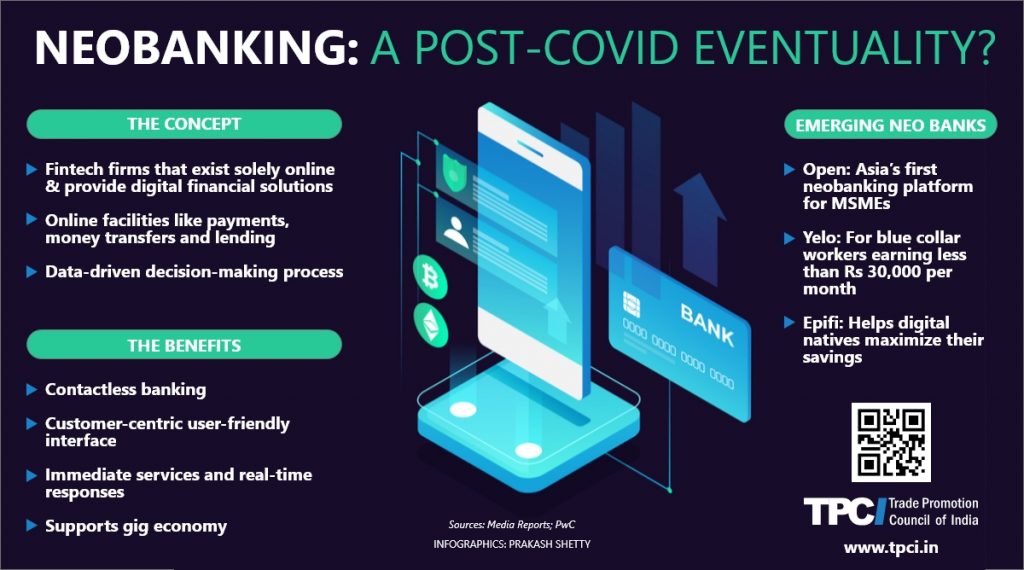Covid-19: The fertile ground for the blossoming of neobanking in India
• India has made great strides in ensuring that her citizens have access to digital services. And given the mounting number of COVID-19 cases, this need to go digital has become more important than it was four years ago when the government undertook demonetization.
• Neobanking institutions provide a number of advantages that these financial institutions offer include a mobile bank account, linked debit card & reduced human interface.
• However, neobanking is still in its nascent stages in the country and has its own set of teething problems like overcoming customer inertia and lack of in-branch services for higher loan amounts.
• To sum up, while the neobanking opportunity is an attractive one, it is going to take a focused effort to build a product platform in this space that offers real value and is a profitable model too.

Back in 2016, the government in its fight against corruption, vowed to move to a ‘less cash economy’ when it undertook demonetisation. This major financial move also led to a surge in online digital payment apps like Paytm, BHIM app and Google pay across the country.
In a short span of 3 years, the times have changed again. On the brighter side, according to an RBI annual report, between, 2017 and 2018, India’s mobile banking users increased by 13% and 92% in value and volume terms, respectively. On the not so bright sight, COVID-19 has given birth to fears pertaining to the contamination of coins and notes with this transmissible virus. Consumers are also worried about the possibility of banking professionals being infected with the contagion and thereby, becoming vectors of this disease in the process. Thus, the need to embrace digital transactions has become more urgent and pertinent than it was four years ago. Neobanking is one solution to facilitate this shift.
Typically, a neobank includes under its umbrella a plethora of financial service providers catering to modern tech-savvy customers. These fintech firms provide digital and mobile-first financial solutions including payments, money transfers and lending through online platforms and apps. What makes these banks truly innovative and distinct from their traditional counterparts is that they’re driven by data to arrive at a decision-making process. At the same time, they’re not the same as digital banks, although they appear to be based on the mobile-first approach and emphasize on digital operating models. This is because, unlike a digital bank, a neobank exists solely online — without any physical branches and independently or in partnership (in case of India) with traditional banks.
Albeit neobanking might seem like a new kid on the block, this idea is being successfully implemented in other parts of the world. Globally, neobanking has witnessed a CAGR of 50.6% between 2016 and 2020 and is valued at US$ 50.2 million in 2020. A case in point is Nubank, the largest FinTech company in Latin America. Headquartered in São Paulo, Brazil, Nubank provides 100% digital services, which includes a digital account, international credit card and personal loans. Another popular case in point is Xinja, an Australia-based neobank that offers financial management, home loans, debit cards and prepaid cards. UK, too has a prominent neobank, Revolut, that offers basic banking services, currency exchange services, stock trading and cryptocurrency trading.
Of late, India too has seen the mushrooming of such banks. Leading examples include Open, which prides itself to be Asia’s first neobanking platform for small and medium-scale businesses and startups. Another example of this business model is Yelo, which offers savings, remittance & micro-credit to blue collar workers earning less that Rs 30,000 per month. Meanwhile, Epifi aims to help demystify the finances of digital natives and helps them maximize their savings. According to findings from Venture Intelligence, neobanks in India raised US$ 116 million in 2019, recording a seven-times jump year-on-year.

What adds to the greater adoption of neobanking in the country is that this form of banking brings with it a string of benefits, apart from annihilating the need for human interaction and hence, the chances of getting inflected by the virus:
i. One major advantage that this school of banking brings with it is that it facilitates a hassle-free process of creating a bank account, which can be a very daunting task in a quintessential brick and mortar structure bank. They also make international transactions quite seamless.
ii. What adds to the popularity of these banks is their customer-centric user-friendly interface. Neobanks could also potentially offer customers value in being a single point of access to a variety of financial instruments.
iii. Neobanks strive to deliver real-time notifications and explanations of any charges and penalties incurred by the customer. This creates an element of transparency and trust for their users. This helps their clientele in managing their finances in a more structured and informed manner.
iv. These financial institutions also help elucidate the experience of banking for their customers by offering dashboard solutions and an ease in understanding the insights for services such as payments, payables and receivables and bank statements.
v. It offers convenience to the country’s hyper-connected, highly informed, value-driven young customers who expect immediate services and real-time responses and want to be spared the menace of queuing at bank branches for teller-controlled transactions.
vi. These banks have contributed to the success of the gig economy in emerging markets like India, Brazil, and Indonesia. Of the 6.33 crore MSMEs in the country, a significant number of them have been either out or under-served by traditional banks’ operational ambit, depriving them of formal banking and credit needs. They face difficulties when it comes to tracking and forecasting cash-flows, effectively managing account receivables & payables. Neobanks can step in over here and help the MSME sector reach the pinnacle of growth.
While neobanks seem to perform fairly well in the country, they are still at a relatively nascent stage have their own set of teething problems.
i. The first major challenge that these institutions face pertains to the fact that the Reserve Bank of India has no virtual banking licences owing to its concerns over cryptocurrency transactions. The central bank remains stern that brick-and-mortar bank branches are imperative to serve customers and redress their disputes and grievances in person.
To overcome this challenge, neobanks are outsourcing their banking responsibilities to those with licences. The flipside of this is that it puts them in a weaker negotiating position when it comes to revenue sharing with their partners.
ii. This is related to the hurdle of overcoming the initial customer inertia. Since neobanks offer a relatively narrower range of financial products and they don’t offer in-branch services when dealing with huge amounts of loans, quite a few prospective customers fear using them.
iii. This gives birth to the challenge of targeting a specific set of clients. Neobanks need to do their share of in-depth research when it comes to arriving at the right product-market fit for addressable customer segments.
iv. Another challenge when it comes to winning consumer trust is that due to debacles like the recent Yes Bank saga, public trust in private financial institutions is not very robust and can erode quickly. Another case in point is that one of the directors of the well-funded neobank Judo, fell prey to a phishing scam, forcing the bank to urgently upgrade its defences.
v. Another challenge that neobanks face is competition from leading private banks. Not only do lenders like HDFC Bank and ICICI Bank still dominate the banking sector in India, they are also planning to increase their share in net banking. A case in point is Kotak Mahindra, which already operates a digital banking product called Kotak 811.
To sum up, neobanks offer numerous benefits like accessibility, suitability and cost-effective customer- centric banking solutions to their digitally active users. However, they face two major barriers – winning trust among users and overcoming regulatory barriers. A co-branding arrangement with an established bank would work well for them, as not only will they be able to cross the regulatory challenges created by the RBI, but they will also be able to gain some credibility in the eyes of their customers.
Further, how well they tackle issues like data and cyber security, seamless API integration and expansion of products and services will be fundamental to their success.













Leave a comment